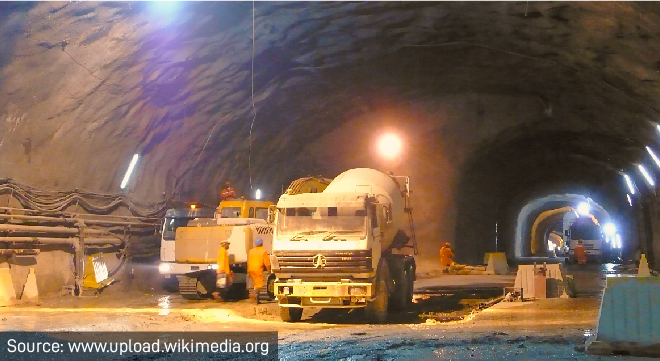The Supreme Court of Appeal (SCA) has upheld the Gauteng provincial government’s claim against Zurich Insurance for the cost of repairing damage caused during the construction of tunnels for the Gautrain.
The High Court in Johannesburg had found that Zurich was liable to indemnify the provincial government for the damage to the tunnels, and it was liable to pay whatever damages were proved “in due course”.
The matter concerned tunnels between Rosebank and Sandton stations, on the one hand, and Sandton and Marlboro Portal, on the other.
The insured in terms of the policy included the province, the Bombela Concession Company (Pty) Ltd, which operates the Gautrain, Bombela TKC (Pty) Ltd, the contractor, and all contractors and sub-contractors connected with, among other things, financing, designing constructing, commissioning and operating the Gautrain.
The purpose of the policy was to indemnify the insured against any damage contemplated by it, and to pay to or indemnify the insured for the full cost of the replacement, repair or making good of the damage.
According to the SCA’s unanimous judgment, it was common cause that the tunnels in question did not meet the specifications set as to the maximum permissible levels of water ingress.
In terms of a schedule to the concession agreement, tunnels were to be constructed so that they would comply with specified permissible water-flow limits and were to be sufficiently water-tight to ensure that the long-term hydrological conditions around any of the tunnels would not be disturbed.
When the tunnels were designed, provision was made for the pre-grouting of the rock mass as the excavation process progressed, to prevent excessive water ingress.
Dr Nick Barton, an engineer with “significant” expertise in rock mechanics and whose evidence was accepted by the High Court, said pre-grouting was “inexplicably dropped by the contractor”.
The SCA considered three grounds on which Zurich brought its appeal:
- Whether the province’s claim against Zurich had prescribed;
- Whether the rock mass that surrounds the void of the tunnels was part of the property insured; and
- The propriety and effectiveness of the High Court’s order.
This article will look at why the court rejected the defence of prescription – namely, that the tunnels were completed in 2009, whereas the province served summons some six years later.
Dispute between the province and Bombela
Construction of one of the tunnels was completed by 4 January 2009, and the other by 2 July 2009. Zurich alleged prescription began to run from these dates, and the claim prescribed three years later. The province lodged its claim against Zurich on 5 February 2015 and served summons on 26 February 2015.
According to the SCA, the problem of excessive water ingress into the tunnels arose at an early stage. The province was aware of the problem, but not of its cause, and engaged Bombela about it.
A dispute developed between the province and Bombela about the applicable specifications and whether the tunnels were compliant with them.
In June 2011, the Dispute Resolution Board (DRB) found that, for the most part, the tunnels were compliant with the agreed-upon specification. It ordered Bombela to perform remedial work on a section of the tunnel that was not compliant.
“Once this finding was made, the province was bound by it […] The result was that if the water ingress was the manifestation of damage, the province had to accept that no damage had occurred because, subject to the remedial work that had been ordered by the DRB, the tunnels had been found to be compliant with the specifications,” Judge Clive Plasket wrote in the SCA’s judgment.
The province referred the DRB’s decision to arbitration. An arbitration award was made in November 2013. The arbitration panel found that sections of both tunnels failed to comply with the specifications in that the rate of water infiltration exceeded the maximum permitted infiltration rate.
“It was only after the arbitration award was handed down that the province began, once again, to investigate whether there was damage to the tunnels, as contemplated by the policy.”
Professor Steinar Roald, described as an eminent civil engineering expert in the field of grouting, suggested that the province consult with an expert in rock mechanics, such as Dr Barton.
Dr Barton came to South Africa in April 2014. His investigation concluded that the failure to pre-grout when blasting had caused unnecessary damage to the rock mass surrounding the void of the tunnel.
“It is clear that the province may have suspected for some time that damage to the tunnels had been caused. It could, however, not quite identify the damage or its cause and neither could the assessors when they investigated on the strength of the province’s concerns. It was only when Dr Barton alerted them to the possibility of EDZ4 [excavation disturbance zone four] damage, and then confirmed this to be the case, that the requisite knowledge of damage could be attributed to the province. That occurred in about May 2014,” Judge Plasket said.
‘Complete cause of action’
Judge Plasket said two points had to be emphasised:
- The province acquired actual knowledge of damage in 2014, but it was not possible for it to have had knowledge attributed to it any earlier because of the specialised knowledge and expertise necessary to establish that damage had occurred.
- When Dr Barton deduced that EDZ4 damage had been caused, he established a fact, rather than an inference of negligence or a conclusion of law. Only then could it be said that the province had a “complete cause of action”.
He said prescription began to run in May 2014 and was interrupted by the service of summons in February 2015, some nine months later. Consequently, as far less than three years separated these two events, the province’s claim had not prescribed, and the High Court was correct when it held that the plea of prescription had to fail.




